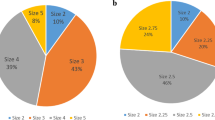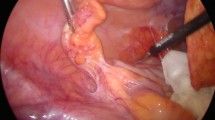Abstract
Introduction
Pelvic organ prolapse (POP) is a common condition, affecting women of all ages. Both abdominal (open and laparoscopic) and vaginal approaches are utilised by the surgeon to achieve the best result for the patient. The aim of this review is to evaluate the most common surgical techniques used to correct POP based on current evidence and our experience.
Method
PubMed was searched using the following terms: ‘pelvic organ prolapse; vaginal prolapse surgery; abdominal prolapse surgery’. These studies were complimented by our personal experience in diagnosing and treating women with prolapse.
Results
Current evidence suggests that attention to the apical compartment is paramount to decrease the risk of recurrent POP. Apical procedures include abdominal sacrocolpopexy (hysteropexy), vaginal uterosacral ligament suspension and sacrospinous ligament suspension. The use of vaginal polypropylene mesh is controversial but may have a place in repair of recurrent prolapse, particularly of the anterior compartment. The vaginal approach has a lower morbidity and is appropriate especially in the elderly or medically compromised. The abdominal sacrocolpopexy or sacrohysteropexy is our preferred procedure when vaginal capacity is reduced and ongoing sexual function is important, or when fertility and future pregnancies are desired.
Conclusion
POP is a complex condition requiring individualised patient care. The pelvic surgeon needs to be proficient in a number of different prolapse surgical techniques so that surgical treatment can be tailored to patient needs.


Similar content being viewed by others
References
Olsen AL, Smith VJ, Bergstrom JO, Colling JC, Clark AL (1997) Epidemiology of surgically managed pelvic organ prolapse and urinary incontinence. Obstet Gynecol 89:501–506
Smith FJ, Holman CD, Moorin RE, Tsokos N (2010) Lifetime risk of undergoing surgery for pelvic organ prolapse. Obstet Gynecol 116:1096–1100
DeLancey JO (1994) The anatomy of the pelvic floor. Curr Opin Obstet Gynecol 6:313–316
Bump RC, Mattiasson A, Bo K, Brubaker LP, DeLancey JO, Klarskov P et al (1996) The standardization of terminology of female pelvic organ prolapse and pelvic floor dysfunction. Am J Obstet Gynecol 175:10–17
Jha S, Moran P (2011) The UK national prolapse survey: 5 years on. Int Urogynecol J Pelvic Floor Dysfunct 22:517–528
Jha S, Moran PA (2007) National survey on the management of prolapse in the UK. Neurourol Urodyn 26:325–331; discussion 32
Vanspauwen R, Seman E, Dwyer P (2010) Survey of current management of prolapse in Australia and New Zealand. Aust N Z J Obstet Gynaecol 50:262–267
Dwyer PL, O’Reilly BA (2004) Transvaginal repair of anterior and posterior compartment prolapse with Atrium polypropylene mesh. BJOG 111:831–836
Demirci F, Ozdemir I, Somunkiran A, Gul OK, Gul B, Doyran GD (2007) Abdominal paravaginal defect repair in the treatment of paravaginal defect and urodynamic stress incontinence. J Obstet Gynaecol 27:601–604
Shippey SH, Quiroz LH, Sanses TV, Knoepp LR, Cundiff GW, Handa VL (2010) Anatomic outcomes of abdominal sacrocolpopexy with or without paravaginal repair. Int Urogynecol J 21:279–283
Viana R, Colaco J, Vieira A, Goncalves V, Retto H (2006) Cystocele—vaginal approach to repairing paravaginal fascial defects. Int Urogynecol J Pelvic Floor Dysfunct 17:621–623
Morse AN, O’Dell KK, Howard AE, Baker SP, Aronson MP, Young SB (2007) Midline anterior repair alone vs anterior repair plus vaginal paravaginal repair: a comparison of anatomic and quality of life outcomes. Int Urogynecol J Pelvic Floor Dysfunct 18:245–249
Dwyer P (2006) Evolution of biological and synthetic grafts in reconstructive pelvic surgery. Int Urogynecol J 17:10–15
Rane A, Kannan K, Barry C, Balakrishnan S, Lim Y, Corstiaans A (2008) Prospective study of the Perigee system for the management of cystocoeles—medium-term follow up. Aust N Z J Obstet Gynaecol 48:427–432
Moore RD, Beyer RD, Jacoby K, Freedman SJ, McCammon KA, Gambla MT (2010) Prospective multicenter trial assessing type I, polypropylene mesh placed via transobturator route for the treatment of anterior vaginal prolapse with 2-year follow-up. Int Urogynecol J 21:545–552
Culligan PJ, Littman PM, Salamon CG, Priestley JL, Shariati A (2010) Evaluation of a transvaginal mesh delivery system for the correction of pelvic organ prolapse: subjective and objective findings at least 1 year after surgery. Am J Obstet Gynecol 203:506 e1–506 e6
Cundiff GW, Fenner D (2004) Evaluation and treatment of women with rectocele: focus on associated defecatory and sexual dysfunction. Obstet Gynecol 104:1403–1421
Paraiso MF, Barber MD, Muir TW, Walters MD (2006) Rectocele repair: a randomized trial of three surgical techniques including graft augmentation. Am J Obstet Gynecol 195:1762–1771
Murphy M (2008) Clinical practice guidelines on vaginal graft use from the society of gynecologic surgeons. Obstet Gynecol 112:1123–1130
Shull BL, Bachofen C, Coates KW, Kuehl TJ (2000) A transvaginal approach to repair of apical and other associated sites of pelvic organ prolapse with uterosacral ligaments. Am J Obstet Gynecol 183:1365–1373; discussion 73–74
Margulies RU, Rogers MA, Morgan DM (2010) Outcomes of transvaginal uterosacral ligament suspension: systematic review and metaanalysis. Am J Obstet Gynecol 202:124–134
Barber MD, Visco AG, Weidner AC, Amundsen CL, Bump RC (2000) Bilateral uterosacral ligament vaginal vault suspension with site-specific endopelvic fascia defect repair for treatment of pelvic organ prolapse. Am J Obstet Gynecol 183:1402–1410; discussion 10–11
Buller JL, Thompson JR, Cundiff GW, Krueger Sullivan L, Schon Ybarra MA, Bent AE (2001) Uterosacral ligament: description of anatomic relationships to optimize surgical safety. Obstet Gynecol 97:873–879
Dwyer PL, Fatton B (2008) Bilateral extraperitoneal uterosacral suspension: a new approach to correct posthysterectomy vaginal vault prolapse. Int Urogynecol J Pelvic Floor Dysfunct 19:283–292
Fatton B, Dwyer PL, Achtari C, Tan PK (2009) Bilateral extraperitoneal uterosacral vaginal vault suspension: a 2-year follow-up longitudinal case series of 123 patients. Int Urogynecol J Pelvic Floor Dysfunct 20:427–434
McCall M (1957) Posterior culdeplasty; surgical correction of enterocele during vaginal hysterectomy: a preliminary report. Obstet Gynecol 10:595–602
Cruikshank SH, Kovac SR (1999) Randomized comparison of three surgical methods used at the time of vaginal hysterectomy to prevent posterior enterocele. Am J Obstet Gynecol 180:859–865
Richter K, Albrich W (1981) Long-term results following fixation of the vagina on the sacrospinal ligament by the vaginal route (vaginaefixatio sacrospinalis vaginalis). Am J Obstet Gynecol 141:811–816
Goldberg RP, Tomezsko JE, Winkler HA, Koduri S, Culligan PJ, Sand PK (2001) Anterior or posterior sacrospinous vaginal vault suspension: long-term anatomic and functional evaluation. Obstet Gynecol 98:199–204
Sze EH, Meranus J, Kohli N, Miklos JR, Karram MM (2001) Vaginal configuration on MRI after abdominal sacrocolpopexy and sacrospinous ligament suspension. Int Urogynecol J Pelvic Floor Dysfunct 12:375–379; discussion 79–80
Meschia M, Bruschi F, Amicarelli F, Pifarotti P, Marchini M, Crosignani PG (1999) The sacrospinous vaginal vault suspension: critical analysis of outcomes. Int Urogynecol J Pelvic Floor Dysfunct 10:155–159
Colombo M, Milani R (1998) Sacrospinous ligament fixation and modified McCall culdoplasty during vaginal hysterectomy for advanced uterovaginal prolapse. Am J Obstet Gynecol 179:13–20
Dietz V, van der Vaart CH, van der Graaf Y, Heintz P, Schraffordt Koops SE (2010) One-year follow-up after sacrospinous hysteropexy and vaginal hysterectomy for uterine descent: a randomized study. Int Urogynecol J Pelvic Floor Dysfunct 21:209–216
Elmer C, Altman D, Engh ME, Axelsen S, Vayrynen T, Falconer C (2009) Trocar-guided transvaginal mesh repair of pelvic organ prolapse. Obstet Gynecol 113:117–126
Abbasy S, Kenton K (2010) Obliterative procedures for pelvic organ prolapse. Clin Obstet Gynecol 53:86–98
Nygaard IE, McCreery R, Brubaker L, Connolly A, Cundiff G, Weber AM et al (2004) Abdominal sacrocolpopexy: a comprehensive review. Obstet Gynecol 104:805–823
Fynes M, Goh J, Chong C, Murray C, Rosamilia A, Dwyer P et al (2001) Abdominal sacral colpopexy for vaginal vault prolapse. Int Urogynecol J Pelvic Floor Dysfunct 12:14
Cvach K, Cundiff G (2010) Abdominal sacral hysteropexy: clinical outcomes compared to abdominal sacral colpopexy with concurrent hysterectomy. In: ICS/IUGA meeting, Toronto. Abstract no. 677
Lowenstein L, Fitz A, Kenton K, FitzGerald MP, Mueller ER, Brubaker L (2009) Transabdominal uterosacral suspension: outcomes and complications. Am J Obstet Gynecol 200:656 e1–656 e5
Maher C, Feiner B, Baessler K, Adams EJ, Hagen S, Glazener CM (2010) Surgical management of pelvic organ prolapse in women. Cochrane Database Syst Rev: CD004014
Sanses TV, Shahryarinejad A, Molden S, Hoskey KA, Abbasy S, Patterson D et al (2009) Anatomic outcomes of vaginal mesh procedure (Prolift) compared with uterosacral ligament suspension and abdominal sacrocolpopexy for pelvic organ prolapse: a Fellows’ Pelvic Research Network study. Am J Obstet Gynecol 201:519 e1–519 e8
Maher CF, Qatawneh AM, Dwyer PL, Carey MP, Cornish A, Schluter PJ (2004) Abdominal sacral colpopexy or vaginal sacrospinous colpopexy for vaginal vault prolapse: a prospective randomized study. Am J Obstet Gynecol 190:20–26
Maher CF, Feiner B, DeCuyper EM, Nichlos CJ, Hickey KV, O’Rourke P (2011) Laparoscopic sacral colpopexy versus total vaginal mesh for vaginal vault prolapse: a randomized trial. Am J Obstet Gynecol 204:360 e1–360 e7
Diwadkar GB, Barber MD, Feiner B, Maher C, Jelovsek JE (2009) Complication and reoperation rates after apical vaginal prolapse surgical repair: a systematic review. Obstet Gynecol 113:367–373
Conflict of interest
None.
Author information
Authors and Affiliations
Corresponding author
Rights and permissions
About this article
Cite this article
Cvach, K., Dwyer, P. Surgical management of pelvic organ prolapse: abdominal and vaginal approaches. World J Urol 30, 471–477 (2012). https://doi.org/10.1007/s00345-011-0776-y
Received:
Accepted:
Published:
Issue Date:
DOI: https://doi.org/10.1007/s00345-011-0776-y




